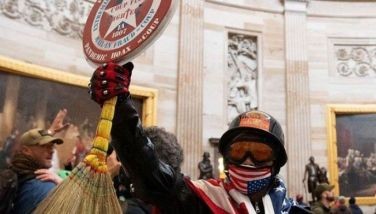Lawsuit: Cubans who scaled Keys lighthouse should stay in US
MIAMI - A group of migrants who fled Cuba in a homemade boat and climbed onto a 136-year-old lighthouse off the Florida Keys should be allowed to stay in the US, according to a federal lawsuit filed on their behalf.
The lawsuit filed Tuesday contends that the 109-foot American Shoal lighthouse is US territory and should be considered the same as dry land. Under the "wet foot, dry foot" policy, Cubans who reach US shores are generally allowed to remain in this country, while those intercepted at sea usually go back.
The lighthouse, about seven miles from Sugarloaf Key on a reef in the Florida Straits, should be viewed the same as a bridge, rock jetty or pier, the lawsuit contends.
The 21 Cubans who climbed the structure last week when their boat malfunctioned are currently aboard a Coast Guard cutter, according to Lt. Cmdr. Gabe Somma. He said they will remain there until their status is settled.
"By virtue of their entry and arrival on US territory, the American Shoal lighthouse, the 21 refugees have become entitled to certain rights," the lawsuit says. "This would entitle each plaintiff due process in the United States."
No judge has ruled on whether offshore lighthouses constitute US territory. But there is some precedent from 2006, when a group of 15 Cuban migrants landed on a part of the abandoned Seven Mile Bridge in the Keys that is no longer connected to dry land.
US immigration officials determined the bridge section was not US territory and ordered the Cubans returned to the communist island. But US District Judge Federico Moreno later ruled that decision was wrong, and eventually many of the Cubans in that case did return to the US
"The historic bridge, which the state of Florida owns and pioneer Henry Flagler built to develop the tip of Florida, is indeed part of the United States despite its present lack of use," Moreno wrote in 2006.
Now a different Miami judge must decide if the lighthouse, a structure built in 1880 on a platform that stands above the water on iron pylons, is in the same category, or whether it is more like an ocean-moored buoy that might not be US territory. The lawsuit seeks a decision on an emergency basis, but a hearing has not yet been scheduled.
A former federal prosecutor said the case is anything but clear-cut.
"Perhaps the government will decide to allow the refugees in this case to seek asylum here in order to avoid further litigation," said attorney David S. Weinstein, now in private practice. "Or, they will decide to litigate in order to avoid setting a new precedent."
The lawsuit names top Homeland Security, State and Justice department officials as defendants along with US Citizenship and Immigration Services, which handles processing of Cuban migrants once they reach US shores. A call seeking comment from that agency was not immediately returned Yesterday.
- Latest
- Trending
































